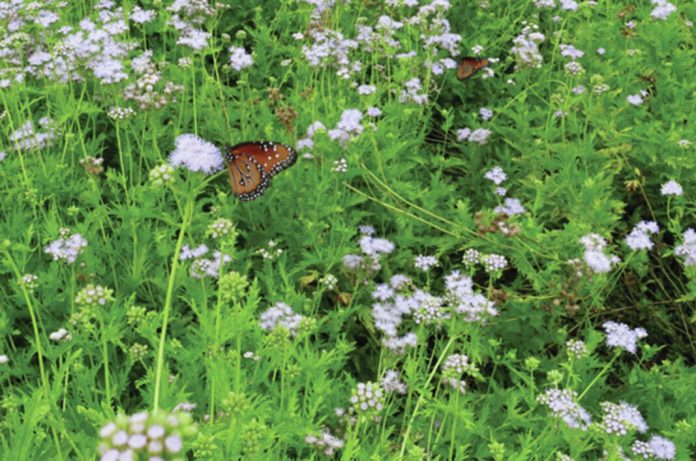
Gregg’s blue mistflower has been named a Texas Superstar plant for its low maintenance, long bloom period and penchant for attracting pollinators, especially butterflies.
Mike Arnold, Ph.D., professor in the Texas A&M Department of Horticultural Sciences, director of The Gardens at Texas A&M University and Texas Superstar executive board member, said the plant has been a notable Texas wildflower for decades.
Gregg’s blue mistflower, Conoclinium greggii, goes by several names – Gregg’s mistflower, palmleaf thoroughwort, Texas ageratum or its former botanic name Eupatorium greggii.
It is a herbaceous perennial Texas native plant. Plants established in spring provide late summer and fall seasonal color in regions where cold prohibits overwintering.
This Trans-Pecos native is quite drought tolerant but does require well-drained soils in more mesic regions, Arnold said. Conoclinium coelestinum is a closely related herbaceous perennial with similar flowers but unlobed leaves that is sometimes also known as blue mistflower, however it lacks the drought tolerance and Texas toughness of Conoclinium greggii.
“Give it a sunny spot in well-drained soil and forget about it,” he said. “It’s extremely low maintenance and carefree. It blooms for a long time and into late summer and fall during that period when there is not much color in landscapes, and it is naturally attractive to butterflies and other pollinators. There is a lot to love about Gregg’s blue mistflower.”
To be designated a Texas Superstar, a plant must perform well for growers throughout the state. Texas Superstars must also be easy to propagate, ensuring the plants are widely available and reasonably priced.
Get to know Gregg’s blue mistflower
Arnold said Gregg’s blue mistflower is a “king among butterfly plants” for late summer and fall landscapes that attract fluttering clouds of the pollinator insects. Numerous butterfly species, including queens and migrating monarch butterflies flock to the flowers.
Plants produce clusters of small composite sky blue or baby blue to lavender-blue flowers that bloom continuously for months, Arnold said. Yellow flowering perennials such as Mexican mint marigold, Tagetes lucida, make excellent companion plants for contrasting colors.
Growth habits are initially upright, and Gregg’s blue mistflower grows taller than wide before spreading out. Cultivars are available with more compact habits or with differing flowering patterns. Plants can slowly sucker or seed to form colonies, which are even more attractive than a single plant.
“If you have grown old-fashioned Mexican ageratums, Ageratum houstonianum, think of Gregg’s blue mistflower as those on steroids,” he said. “They tolerate tougher sites, grow taller and come back year after year to grace our demanding regional gardens. That is a pretty good description of what Gregg’s mistflower will become.”
How to care for Gregg’s blue mistflower
Gregg’s blue mistflower can be planted from containers at any time except for the dead of winter in northern parts of the state. They bloom from late spring to late fall and peak in late summer and fall.
Plants prefer full sun to mostly sunny locations. Flowering reduces as shade increases. They are adapted to a wide range of soil pH levels and textures if they are reasonably well-drained. Do not plant Gregg’s blue mistflower in soils that maintain moisture, especially areas that remain wet during the winter.
Arnold recommends using them as a perennial fixture in mixed borders, as pockets of color, in rock gardens, in mass plantings for slopes, for butterfly or pollinator gardens or small-scale groundcover, and to naturalize wildflower areas or pocket prairies. Gregg’s blue mistflower can also be used in mixed fall patio containers.
Initial pinching of the plants will encourage greater canopy density but will not be necessary over time. Once it dies back during winter, Arnold said to clear back the dead foliage after the threat of frost has passed.
“Gregg’s blue mistflower thrives on being ignored once it’s established,” Arnold said. “It might need a little water during extended drought to improve blooms, but the ease of care and its adaptability make it a Texas Superstar. That along with its pop of color and reputation as a pollinator-friendly plant make it a no-brainer.”
Texas Superstar is a registered trademark owned by Texas A&M AgriLife Research. Plants are designated by the Texas Superstar executive board, which comprises nine horticulturists from AgriLife Research, Texas A&M AgriLife Extension Service and Texas Tech University in Lubbock.



